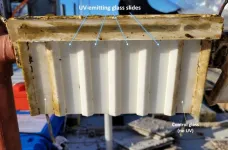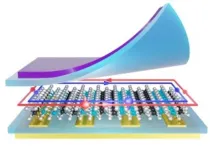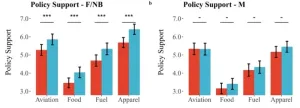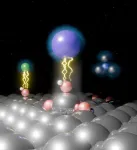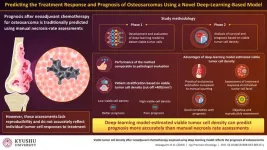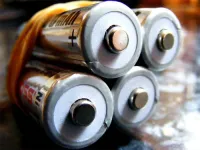(Press-News.org) AMHERST, Mass. – A group of researchers led by University of Massachusetts Amherst engineers have created ultraviolet (UV) rays-emitting glass that can reduce 98% of biofilm from growing on surfaces in underwater environments, as reported in the journal Biofilm.
Biofilm is a slimy layer of various types of microorganisms that grows on wet surfaces. “If you look down your sink and touch the inner side of it—that slimy substance is biofilm,” describes Mariana Lanzarini-Lopes, assistant professor of civil and environmental engineering at UMass Amherst, and a corresponding author on the paper.
Biofilm is a significant issue for underwater applications. The United States Navy estimates that biofilms cost its fleet between $180 and $260 million annually. Biofilm growth on all underwater surfaces increases a ship’s drag and subsequent fuel usage, as well as corrosion damage on ships or oceanographic equipment.
Biofilm can also fog up windows used for cameras and other sensing devices that rely on transparency, and transport non-native species across the seas.
Current solutions for dealing with biofilm rely on chemical agents like biocidal coatings to kill the organisms or nonstick coatings to prevent biofilms from attaching in the first place. However, these methods can have negative effects on the ecosystem and only last for a short duration.
As an alternative to these chemical methods the UMass Amherst team, with funding from the U.S. Office of Naval Research (ONR), developed biofilm-resistant glass using UVC radiation, the shortest and most effective at disinfecting wavelength of UV radiation. Lopes’s lab has already demonstrated that UV side-emitting optical fiber can distribute UVC radiation in small channels, like medical equipment (i.e. endoscopes, catheters and respirators), home devices (coffee makers and refrigerators) and water storage/distribution systems (pipes, bladders, membranes) to inactivate pathogenic organisms and prevent bacteria growth on surfaces.
“A lot of people know about UV for disinfecting surfaces, air and water,” says Lopes. “People started using it a lot more especially because it was really effective for disinfection of the SARS-CoV-2 virus.”
However, in an underwater environment, it’s not as simple as shining UV light onto glass. “We cannot use traditional light sources to distribute light evenly on the surface,” for several reasons, says Leila Alidokht, postdoctoral research associate in Lopes’s lab and lead study author. Light becomes weaker as it moves away from the source, making it difficult to cover large surface areas. The UV waves can also be disrupted by how murky the surrounding water.
Uneven distribution of the UV light gives biofilm-forming microorganisms a foothold and leaves the whole surface vulnerable: “If the biofilm can attach to a part of the surface, it can spread to other parts,” she adds.
The team’s solution is a silica-nanoparticle coating on the glass. “The UV LED is connected from the cross-section of the glass,” Alidokht describes. “As UV enters the glass, we scatter the UV from inside of the glass to the outside,” using these light-scattering nanoparticles. The silica does not absorb the UV rays. The waves continue to bounce off the nanoparticles and through the glass interior which enables an evenly “glowing” glass surface.
To test it, the researchers, in partnership with Florida Tech and the Navy, submerged this UV-emitting glass in the waters of Port Canaveral, Florida for 20 days. Compared to untreated glass, this glass reduced visible biofilm growth by 98%.
“Contrary to external UV irradiation technique, UV-emitting glass inhibits biofilm formation directly at the surface of interest—the surface itself serves as a UVC source,” says Alidokht.
She is excited that this discovery opens the door for diverse disinfection applications. “The developed technology can be used for disinfection of transparent surfaces such as windows of ships, flotation spheres and moored buoys, camera lenses and sensors for oceanographical, agricultural and water treatment applications,” she says.
The team has received a provisional patent for their discovery.
Now that the team has proven that this glass effectively resists biofilm formation (known as biofouling), they are excited to optimize their discovery: testing long-term applications, assessing any effects on the environment and creating larger surface areas.
Another future avenue of exploration: “We’re also trying to prevent biofilm on camera lenses,” adds Lopes. “The maininhibitor of the length of time for deployment [of underwater cameras] is biofouling, so as long as you can decrease the rate of biofouling, you can increase how long you deploy all this optical equipment.”
END
UMass Amherst-led team creates biofilm-resistant glass for marine environments
The invention prevents biofilm formation by 98% and is poised to help solve a major issue for the U.S. Navy
2024-04-02
ELSE PRESS RELEASES FROM THIS DATE:
Heart health declines rapidly after menopause
2024-04-02
A woman’s cardiovascular risk can rise sharply after she goes through menopause, quickly catching up to men of a similar age and health profile, according to new findings presented at the American College of Cardiology’s Annual Scientific Session. Researchers said the study underscores the importance of recognizing and addressing early warning signs of heart disease risk in women as they lose the protective effects of estrogen after menopause.
“This is a unique study cohort of only post-menopausal ...
Majority of people with heart disease consume too much sodium
2024-04-02
Individuals with heart disease stand to gain the most from a low-sodium diet but, on average, consume over twice the recommended daily sodium intake, according to a study being presented at the American College of Cardiology’s Annual Scientific Session.
Sodium is an essential nutrient, but consuming too much can raise blood pressure, which damages blood vessels and forces the heart to work harder. Excess sodium can also cause the body to retain fluid, exacerbating conditions like heart failure. The current U.S. Dietary Guidelines put out by the U.S. Department of Agriculture ...
Study links e-cigarette use with higher risk of heart failure
2024-04-02
People who use e-cigarettes are significantly more likely to develop heart failure compared with those who have never used them, according to one of the largest prospective studies to date investigating possible links between vaping and heart failure. The findings are being presented at the American College of Cardiology’s Annual Scientific Session.
Heart failure is a condition affecting more than 6 million U.S. adults in which the heart becomes too stiff or too weak to pump blood as effectively as it should. It can often lead to debilitating symptoms and frequent hospitalizations as people age. Electronic nicotine products, which include ...
Mapping heart health: AI illuminates neighborhood impact on well-being
2024-04-02
Is the view from your doorstep mostly trees and sky or buildings and grass? The answer could influence your cardiovascular health, according to a study presented at the American College of Cardiology’s Annual Scientific Session. Using an analysis of Google Street View images powered by machine learning, researchers found people living in surroundings rich in sidewalks, trees and clear sky saw a significantly lower risk of major adverse cardiac events.
“A lot of research has shown that environmental factors strongly affect our health. If we can find a way to stratify this risk and provide interventions before cardiovascular events happen, then ...
Researchers discover dual topological phases in an intrinsic monolayer crystal
2024-04-02
Chestnut Hill, Mass (4/2/2024) – Dual topological phases have been discovered in an intrinsic monolayer crystal, a finding that reveals new and unique rule-bending properties in a quantum material, an international team of scientists led by Boston College physicists reported recently in the online version of the journal Nature.
The discovery of a dual topological insulator introduces a new method for creating topological flat minibands through electron interactions, which offer a promising platform for exploring exotic quantum phases and electromagnetism, ...
PLOS and Eurodoc partner to advance Open Science principles
2024-04-02
Brussels, Belgium, and San Francisco, United States - The Public Library of Science (PLOS) and the European Council of Doctoral Candidates and Junior Researchers (“Eurodoc”), today announced a strategic partnership between the organizations to increase awareness of Open Science, its principles, and its implementation into research practices.
“In addition to supporting researchers, we also strive to support the implementation of Open Science principles and increase the adoption of ...
Intergenerational altruism and climate policy support
2024-04-02
Investments in mitigating climate change in many cases benefit future generations more than those alive today. However, initial costs must be borne by those living now, so many climate mitigation policies rely on some level of intergenerational altruism for support. To investigate the strength and shape of intergenerational altruism, Gustav Agneman and colleagues asked Swedish study participants to engage in an experimental task in which they allocated fictional resources across generations, after being told how many descendants they might be expected to have in the next 250 years. On average, participants allocated most of the resources to the present generation, and fewer and ...
Investigating the surface extraction of platinum catalysts in alkaline media
2024-04-02
The pursuit of carbon neutrality drives the exploration of clean energy sources, with hydrogen fuel cells emerging as a promising avenue. In these cells, hydrogen undergoes an electrochemical reaction with oxygen to produce electricity and water. Also, the reverse of this process, called electrolysis, can be used to split the abundantly available water to produce hydrogen and oxygen. These two technologies can work in tandem to provide a clean and renewable source of energy. A pivotal element in these two technologies is the platinum (Pt) electrode.
Hydrogen fuel cells consist of two electrodes: an anode and a cathode, with an ...
AI’s ability to detect tumor cells could be key to more accurate bone cancer prognoses
2024-04-02
Fukuoka, Japan - Researchers at Kyushu University have developed and validated a machine-learning model that can accurately evaluate the density of surviving tumor cells after treatment in pathological images of osteosarcoma—the most prevalent malignant bone tumor. The model can assess how individual tumor cells respond to treatment and can predict overall patient prognosis more reliably than conventional methods.
Surgery and chemotherapy have significantly improved the outcomes of patients with localized osteosarcoma. However, patients with advanced metastatic disease (the stage where cancerous cells have spread to distant tissues) have a low survival rate. ...
New materials discovered for safe, high-performance solid-state lithium-ion batteries
2024-04-02
All-solid-state lithium-ion (Li-ion) batteries with solid electrolytes are non-flammable and have higher energy density and transference numbers than those with liquid electrolytes. They are expected to take a share of the market for conventional liquid electrolyte Li-ion batteries, such as electric vehicles. However, despite these advantages, solid electrolytes have lower Li-ion conductivity and pose challenges in achieving adequate electrode-solid electrolyte contact. While sulfide-based solid electrolytes are conductive, they react with moisture to form toxic hydrogen disulfide. Therefore, there's ...
LAST 30 PRESS RELEASES:
Making lighter work of calculating fluid and heat flow
Normalizing blood sugar can halve heart attack risk
Lowering blood sugar cuts heart attack risk in people with prediabetes
Study links genetic variants to risk of blinding eye disease in premature infants
Non-opioid ‘pain sponge’ therapy halts cartilage degeneration and relieves chronic pain
AI can pick up cultural values by mimicking how kids learn
China’s ecological redlines offer fast track to 30 x 30 global conservation goal
Invisible indoor threats: emerging household contaminants and their growing risks to human health
Adding antibody treatment to chemo boosts outcomes for children with rare cancer
Germline pathogenic variants among women without a history of breast cancer
Tanning beds triple melanoma risk, potentially causing broad DNA damage
Unique bond identified as key to viral infection speed
Indoor tanning makes youthful skin much older on a genetic level
Mouse model sheds new light on the causes and potential solutions to human GI problems linked to muscular dystrophy
The Journal of Nuclear Medicine ahead-of-print tip sheet: December 12, 2025
Smarter tools for peering into the microscopic world
Applications open for funding to conduct research in the Kinsey Institute archives
Global measure underestimates the severity of food insecurity
Child survivors of critical illness are missing out on timely follow up care
Risk-based vs annual breast cancer screening / the WISDOM randomized clinical trial
University of Toronto launches Electric Vehicle Innovation Ontario to accelerate advanced EV technologies and build Canada’s innovation advantage
Early relapse predicts poor outcomes in aggressive blood cancer
American College of Lifestyle Medicine applauds two CMS models aligned with lifestyle medicine practice and reimbursement
Clinical trial finds cannabis use not a barrier to quitting nicotine vaping
Supplemental nutrition assistance program policies and food insecurity
Switching immune cells to “night mode” could limit damage after a heart attack, study suggests
URI-based Global RIghts Project report spotlights continued troubling trends in worldwide inhumane treatment
Neutrophils are less aggressive at night, explaining why nighttime heart attacks cause less damage than daytime events
Menopausal hormone therapy may not pose breast cancer risk for women with BRCA mutations
Mobile health tool may improve quality of life for adolescent and young adult breast cancer survivors
[Press-News.org] UMass Amherst-led team creates biofilm-resistant glass for marine environmentsThe invention prevents biofilm formation by 98% and is poised to help solve a major issue for the U.S. Navy
